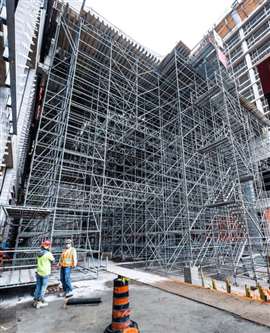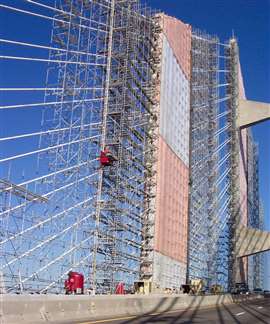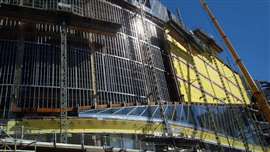Update: SAIA Canadian Council
May 13, 2024
The Scaffold & Access Industry Association’s Canadian Council has a number of big-ticket projects it is currently working on for both Association members, and the industry as a whole, says Canadian Council Chair Rick McKinlay.
 Scaf-Tech recently facilitated the completion of Toronto’s The Well, a mixed-use space seen here, by utilizing Layher Allround scaffolding. (Photo: Layher North America)
Scaf-Tech recently facilitated the completion of Toronto’s The Well, a mixed-use space seen here, by utilizing Layher Allround scaffolding. (Photo: Layher North America)
“The Canadian Council’s primary mission remains to unify, represent and enhance available resources for each provinces in the scaffold and access industry across Canada,” says McKinlay, who also serves as President of the Access Association of Canada. “Our mail goals and objectives continue to be to complete an industry gaps analysis, to review and modify all SAIA safety resources and make them relevant to each province, and to review and create training content to meet the needs of the Association’s Canadian members.”
SA recently sat down with McKinlay for an update on all things Canada. Here’s what he had to say.
Over the past 12 months, what has the Canadian Council been actively working on?
McKinlay: Our efforts have remained heavily focused on the gaps analysis tool that has been under development. The gaps analysis tool (or what we are probably more accurately referring to as a “side-by-side analysis”), lays out the requirements for the various types of scaffold and access equipment across each of the eight most populous provinces.
Specific key criteria as typically outlined in the various regulations for each equipment type can easily be followed across a row of data, literally moving from one side of the country to the other, to see how the regional requirements for that equipment type may be similar – and more importantly to also see how they may differ.
We had set for ourselves a target to have the first working draft completed in time for last year’s Annual Convention in Vancouver, and the Council is happy to have been able to meet that goal.
Between Annual Convention and the recent Committee Week in Charleston, SC, the Council had been able to have the working draft document further refined through peer review, health and safety management perspective review, engineering perspective review, translated from French to English where relevant, and formatted and branded. The goal had been to have the tool ready for submission to the Regulatory and Review Committee for final review ahead of publication in time for or just after Committee Week – a target the Council was again happy to have been able to meet.
During Committee Week, we were also able to have a productive preliminary pre-submission discussion with representation from the Regulatory and Review Committee and were able to receive some very helpful inputs that we agree would make for a better reading document and a better overall tool. We will shortly be working those recommended inputs in, with the expectation to be able to submit the gaps analysis/side-by-side comparison tool to the Regulatory and Review Committee shortly.
 Etobicoke Ironworks Limited manufactures, researches and provides design and engineering services on scaffolding and structural steel products. (Photo: Etobicoke Ironworks Limited)
Etobicoke Ironworks Limited manufactures, researches and provides design and engineering services on scaffolding and structural steel products. (Photo: Etobicoke Ironworks Limited)
The Council continues to meet virtually, fairly regularly, with participants calling in from most of the provinces – which has certainly helped in keeping up the momentum.
Looking forward, what will the Council be focusing on in the coming year?
McKinlay:The council is expecting to be able to fully cap off the first phase of the gaps analysis/side-by-side analysis project. Once the Regulatory and Review process has been completed, we expect to begin publishing, broadcasting and promoting the completed document to get it into the hands of those who can benefit from it, and who, in the past, would had to have taken this upon themselves individually to try to sort out and make sense of.
We are also planning to implement a periodic or annual review process, to ensure that any changes to the regulations are reflected in a living document.
Future activities will include translation into French language for the benefit of our Francophone members and colleagues, expansion to also cover rope access, bringing the remaining provinces and territories into the document, expanding the document scope to encapsulate the relevant CSA standards, as well as expansion in scope to include OSHA regulations and ANSI/UL standards – wouldn’t a full Canada and U.S. comparison be something else! Depending how ambitious the Council participants feel will determine plan of attack to begin chipping away.
Additionally, reflection on some of the recent occurrences in the field experienced by members and relating to interpretation of regulations and standards has also highlighted some areas of need for Council involvement; there are many “gray areas” that seem to be popping up as member companies push for innovative and outside of the box thinking (e.g., access scaffold components being used in non-access scaffold applications), with regulations, codes, and standards often playing catch-up. The council is expecting to be making a push towards helping those member companies who find themselves caught up in those gray areas, and at the same time working with local regulators and policymakers to help raise their awareness and education as our industry continues to evolve. This is certainly an area where leveraging of existing alliances can be of significant benefit.
Also, a recurring theme in many of the discussions that the Council has been involved in relates to training. It seems that a common challenge to most companies is a workforce shortage. Bringing in more and new workers inherently drives a need for increased training. The Council feels that this will likely be a near-future push, as well, and remains open to serve as a resource towards that end.
Are there any upcoming changes to standards/regulations that will impact the Council?
McKinlay: There have been rumblings that there are expected to be some upcoming changes to one or more of the Canadian regional occupational health and safety regulations relating to construction, as well as amendments/reviews currently underway for a few of the CSA standards governing our industry.
 Ontario-based Klimer specializes in mast climbing work platforms and transport platforms. (Photo: Klimer)
Ontario-based Klimer specializes in mast climbing work platforms and transport platforms. (Photo: Klimer)
The importance (and value) in holding periodic reviews of the gaps analysis/side-by-side document is to ensure that any changes requiring update are captured and addressed in a reasonably timely manner. The periodic review process also provides a vehicle to communicate to the members that changes have occurred (or are coming), as well as what they are, further strengthening the association’s position and reputation as the voice of the industry. A further benefit in the way that the Canadian Council team is structured is that the geographic leaders tend to be in the best position to be able to communicate back to the team any upcoming changes that may be in the works.
What would the Council like to relay to readers of SA Magazine?
McKinlay: The Canadian Council remains an available resource for any of the other SAIA members or councils – if there are ways that the council can contribute and provide insight or an alternate perspective on any of the projects being undertaken or issues being experienced in the field, don’t hesitate to get in touch with the council chairs – we’re here for your benefit.
If there are Canada-specific challenges that need guidance or addressing, please also don’t hesitate to reach out.
To learn more about the Canadian Council, visit its website at www.saiaonline.org/canadian.
STAY CONNECTED



Receive the information you need when you need it through our world-leading magazines, newsletters and daily briefings.
CONNECT WITH THE TEAM








